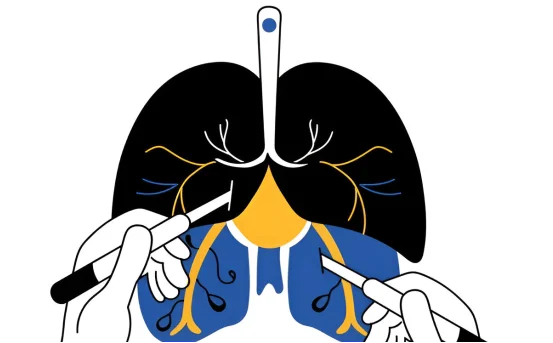The Pneumonectomy is a major surgery that involves removing one lung. Most commonly, it is performed to treat severe lung conditions, such as lung cancer, infections or traumatic injuries. What is pneumonectomy surgery? Pneumonectomy, as a type thoracic surgical procedure, is usually considered when less invasive surgery or medication are ineffective.
Losing a lung can be a frightening thought for many patients. Pneumonectomy, when done under expert supervision and with the latest medical technology, can improve the quality of life for patients and save their lives.
Understanding what is pneumonectomy surgery helps patients and families make informed decisions about their treatment options.
Why Is Pneumonectomy Performed
Pneumonectomy does not constitute a first line treatment. This surgery is often considered when the lung has been affected by the disease or when other resections, such as lobectomy and segmentectomy, are not enough. These are the most important medical reasons to recommend this surgery:
- Lung Cancer:- The most common reason to perform a pneumonectomy is lung cancer. If the tumor is large, centrally located and involves multiple lobes of critical structures or other organs, a pneumonectomy may be required to stop cancer spreading.
- Severe Lung Infections:- In rare, but severe cases, infections that can be fatal such as tuberculosis and fungi can cause serious lung damage. Pneumonectomy is a viable option if antibiotics do not work and the lung has become non-functional or dangerous for the rest of the human body.
- Chronic Inflammatory Diseases:- When bronchiectasis, chronic obstructive lung disease (COPD) or bronchiectasis is advanced and isolated in one lung, doctors may recommend surgery only as a final resort.
- Trauma or Injury:- In severe chest trauma, lung tissue can be destroyed to the point that it cannot repair itself. In these cases, the damaged lung can only be removed.
Pneumonectomy Types
The type of pneumonectomy surgery depends on the side and extent of the lung affected.
- Standard Pneumonectomy:- The entire lung is removed, either the left or right. This is the most common form of lung cancer treatment.
- Extrapleural Pneumonectomy (EPP):- The EPP is a more intensive procedure that involves removing the lung, along with pleura, part of diaphragm and pericardium. This procedure is usually used to treat aggressive tumors such as mesothelioma.
- Sleeve Pneumonectomy:- When a tumor is near the bronchi, this procedure is used. This procedure involves the removal of a lung and a portion of bronchus.
The Pneumonectomy procedure
- This is what the typical surgical procedure looks like.
- Preparation and Evaluation
- Before surgery, patients are evaluated extensively, including CT scans and pulmonary function tests.
It is important to make sure that the remaining lung of the patient can meet the body’s needs for oxygen.
Steps to Surgery
- The pneumonectomy procedure is performed under anesthesia general.
- The thoracotomy is performed on the side of chest.
- The surgeon carefully removes the affected lung, while preserving other structures.
- Sometimes the space left behind will be filled with fluid or air, which your body will absorb in time.
Duration
The procedure takes between 2-4 hours depending on the complexity.
Recovery after Pneumonectomy
The recovery from pneumonectomy involves a gradual, multi-step process, which includes hospitalization, monitoring and postoperative care.
Hospital Recovery
- Most patients are hospitalized for between 5-10 days.
- During this time, it is important to provide pain management, respiratory support, and infection control.
- Chest tubes can be used to drain fluids and monitor the pressure.
Home Recovery
It may take up to 12 weeks for a full recovery.
The pulmonary rehabilitation program includes physical therapy, nutritional support, and breathing exercises.
Follow-up appointments are necessary to monitor lung health, wound healing and possible complications.
Complications and Risks
Pneumonectomy is a major operation that carries some risks. This is especially true because the organ being removed is vital. Complications include:
Infection or pneumonia
- Bleeding
- Blood Clots
- Respiratory failure
- Empyema (fluid buildup)
- Cardiac problems, including arrhythmias
When performed by an experienced surgeon in a specialized facility, risks are minimized. The key to improved outcomes is proper pre-operative evaluation, and after-operative care.
Living with One Lung: Expectations
The majority of patients adapt well to living with only one lung. Although there may be some limitations to physical activity and stamina for many patients, they are able to return back into their normal daily routines including work and mild exercises.
Here are some lifestyle tips and changes that you can make to improve your results:
- If applicable, stop smoking
- Avoid exposure to allergens and pollutants
- Maintain a healthy body weight by eating a balanced diet
- Regularly vaccinated against influenza and pneumonia
- Exercises to improve lung capacity include breathing exercises
Conclusion
The Pneumonectomy Surgery is an important but life-saving surgery used to treat lung cancer and other advanced lung diseases. Modern techniques and expert care make the outcome more successful.
Consult a thoracic or pulmonologist if you or someone close to you has been advised for a pneumonectomy. They can help you understand the options available, the risks and the benefits. Many patients can live a fulfilling life with just one lung if they receive the right support and undergo rehabilitation.























